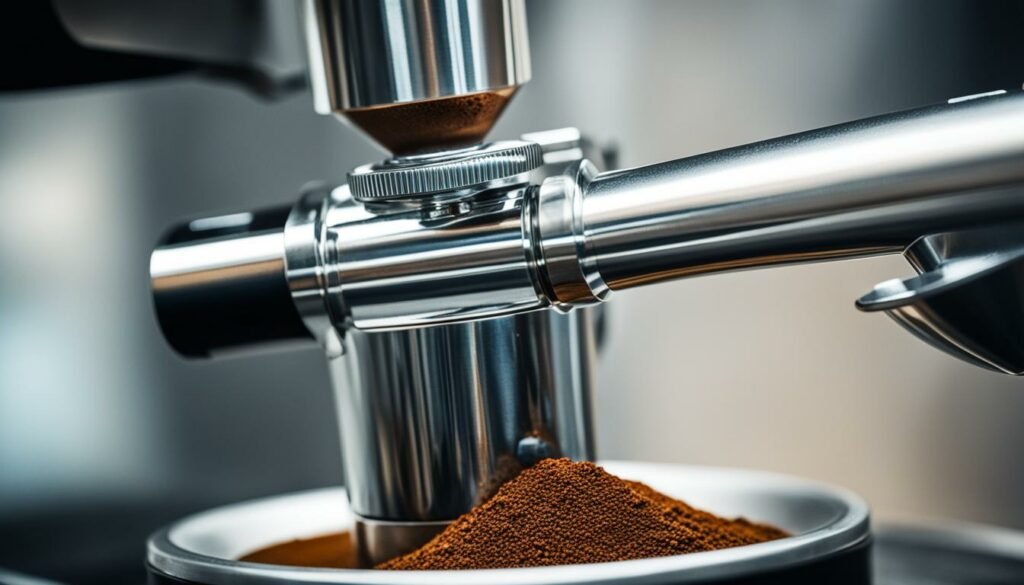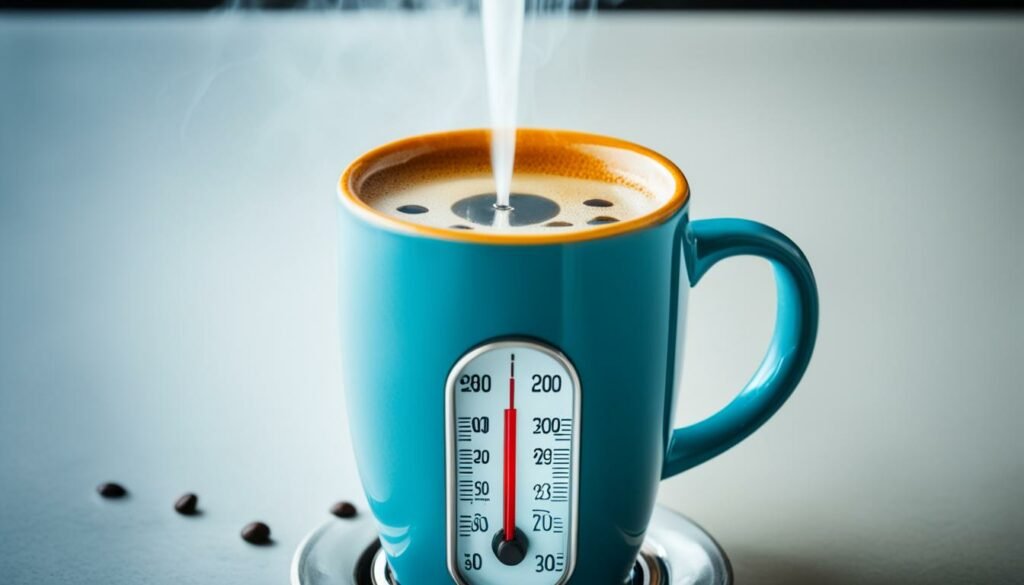Imagine you’re sitting in a cozy café. You’re wrapped in the rich aroma of freshly made espresso. The barista pulls a shot with expert care. Their methods extract every single flavor from the coffee grounds. With a flick of their wrist, you receive a smooth, velvety espresso shot, a delight on your tongue.
How do baristas make that perfect shot? We aim to find out. This article will explore espresso extraction techniques in depth. We’ll cover the basics of brewing, the details of dose and yield, the importance of grinding. We’ll also look at espresso machine settings. By the end, you’ll have everything you need to perfect your espresso shot.
So, grab your favorite mug. Let’s start the journey to unravel the secrets of making the perfect espresso. But before we do, let’s take a moment to appreciate the cup of espresso our passionate barista has prepared:
Ready to learn the secrets of a perfect shot? Let’s dive into the core of espresso extraction. We’ll discover the tips that will make your espresso exceptional.
Understanding the Fundamentals of Espresso Extraction
Creating the perfect espresso shot is all about knowing the basics. You need to unlock the flavors and smells from the coffee. This makes your cup rich and satisfying. We will look at the key parts of how espresso is made. This includes water temperature, pressure, grind size, and how long it brews.
First off, water temperature is key. It needs to be between 195°F (90.6°C) and 205°F (96.1°C) for the best tasting espresso. This keeps the coffee from burning while getting all its goodness. Keeping the water temperature steady stops your drink from tasting bitter or sour.
Water pressure is the next big thing. The machine pushes hot water through the coffee grounds. This way, it pulls out all the great flavors we love. The pressure is set at 9 to 10 bars. That’s the perfect amount to get the most out of your espresso, including that creamy layer on top.
Don’t forget about the grind size. How fine or coarse the coffee is ground affects your drink. Finer grinds slow down the brewing, adding depth to the flavor. Coarser grinds make a lighter espresso. So, pick the right one for the taste you want.
| Factors | Explanation |
|---|---|
| Water temperature | The perfect range for water is between 195°F (90.6°C) and 205°F (96.1°C). This keeps coffee from burning but pulls out its flavors. |
| Water pressure | The machine uses 9 to 10 bars of pressure. It draws the oils and flavors from the coffee. This also makes the crema and improves the taste. |
| Grind size | The size of your coffee grounds decides how quickly flavor is extracted. Fine grounds make a stronger taste. Coarse ones make it lighter. |
| Extraction time | How long the brewing takes affects flavor. Too little brewing means weak, sour espresso. Too long makes it bitter. |
Lastly, how long you brew the espresso is super important. This decides if the taste is just right. Too short and it’s weak and sour. Brew too long, it becomes bitter. Just the right time gives a balanced and pleasant shot.
Knowing these basics lets you make great espresso every time. Next, we’ll dive into specific ways and tweaks to perfect your espresso.
Espresso Extraction Techniques: Achieving the Perfect Balance
To make the perfect espresso shot, you need to choose the right extraction techniques. You must think about things like how much coffee to use, how much espresso you get, and the relationship between the two. You should also consider time and how the beans were grown. These factors help make a great espresso.
Decoding Dose, Yield, and Ratio
The amount of coffee, or dose, impacts the espresso’s flavor and strength. The perfect dose varies based on what coffee you use, what you like, and the machine you have. Try different amounts to find what tastes best to you.
The yield is the amount of espresso you get from the coffee grounds. It changes the flavor’s strength in your cup. More liquid often means a weaker taste. Less liquid can make your espresso taste stronger. Experiment with the amount of espresso you make to get the taste you love.
The ratio shows the connection between the coffee dose and the espresso yield. For instance, a 1:2 ratio means you use one part coffee to make two parts of espresso. This balance impacts the flavor and strength of your espresso shot. Changing the ratio lets you adjust your coffee’s taste. Different types of coffee and brewing methods might need different ratios for the best results.
Timing Your Espresso Shot to Perfection
The time it takes for the water to pass through the coffee grounds is crucial. This extraction time determines the flavor of your espresso. It is measured in seconds.
The grind size, dose, water heat, and pressure affect the extraction time. These factors change how your espresso tastes. Keep an eye on the time and adjust as needed to get the perfect shot. This stops your espresso from being too weak or too strong.
Adjustments Based on Bean Age and Conditions
Coffee bean age is critical. Freshly roasted beans have more carbon dioxide, affecting the taste. You might need to change the amount of coffee, the yield, and the time to get the best flavor. As beans get older, you’ll need to tweak how you make your espresso to keep the flavors right.
External factors like humidity and where the coffee is grown also change how the flavors extract. High humidity can alter the coffee’s moisture, affecting its taste. Where the coffee is grown changes the water’s boiling point, which also needs adjusting for the brewing temperature. Make the necessary changes based on these conditions to have the best shot.
Thinking about these details and making the right adjustments can perfect your espresso. These steps help bring out the best in your coffee beans.
The Significance of Grinding in Espresso Brewing Methods
Grinding is key to making the perfect espresso shot. The size of the grind affects the taste, strength, and quality of the espresso. Choosing the right grinder and adjusting it correctly are crucial steps.
Choosing the Right Grinder for Uniform Grounds
Invest in a good grinder for consistent taste. Blade and burr grinders are the two main types. Blade grinders are cheaper but don’t grind evenly. Burr grinders give you better control of the grind size and produce even grounds. Look for a grinder that has many grind settings, is easy to use, and lasts long.
Calibrating Your Grinder for Optimal Coarseness
After picking the best grinder, set it to the right coarseness for espresso. Espresso asks for a fine grind, making flavors perfect. You don’t want over or under-extraction. Use the grinder’s manual to set it correctly.
Grinding is central to great espresso. Choosing and fine-tuning your grinder is worth the effort. This work means every espresso you make will be a joy to drink.

Expert Tips for Mastering Espresso Machine Settings
Getting your espresso machine settings right is crucial for a perfect espresso. We’ll share tips for using your machine’s settings to get the best espresso. We’ll cover keeping the right brew temp, using different pressures, and how pre-infusion helps.
Maintaining Consistent Brewing Temperatures
Having the right temperature is key for good espresso. Changing temps can mess up your shot’s taste. Here’s how to keep your brews at the perfect temp:
- Make sure your espresso machine is accurate and gets checked often for temp changes.
- Warm up your machine first to keep the temp steady and avoid sudden drops.
- Think about getting a machine that controls the temp precisely.
Keeping an eye on the temp will make your espresso taste the same every time. This unlocks your beans’ best flavors.
Pressure Profiling for a Custom Espresso Flavor
Pressure profiling lets you adjust the pressure for a unique espresso taste. Changing the pressure can customize your drink. Here’s how to play with pressure:
- Try different pressure steps to see the flavor changes each brings.
- Take notes on what changing pressures do to the taste.
- Adjust your pressure plan to get the taste you want.
Getting pressure profiling right takes practice. It can bring out new tastes in your espresso, letting you make special, unique cups.
Exploring the Impact of Pre-Infusion and Extraction Pressure
Pre-infusion can level up your espresso’s taste. It makes sure the flavors develop evenly. To master pre-infusion, try these steps:
- Set your machine to pre-infuse the grounds before the main brew starts.
- Test different pre-infusion times to see what works best for your taste.
Extraction pressure is the force that makes your espresso bold or delicate. By adjusting this, you can fine-tune your drink’s flavor to your liking.
Understanding your espresso machine’s settings can make your espresso better. You’ll pull out more flavor from your beans, making amazing shots with great taste and smell.

Optimizing Espresso Extraction for a Smoother Profile
To get smooth and tasty espresso, it’s key to get the extraction just right. You need to look at things like the size of the coffee grounds, how much coffee you use, and the time it takes. These help you make sure each shot tastes great and goes down easy.
Grind Size: The size of your grind is very important in getting the best flavors out. If the grind is too small, your espresso will be bitter. If it’s too big, the taste will be weak. Try different settings to find what works best for a rich and smooth coffee.
Dose: How much coffee goes into the portafilter matters too. More coffee can make the flavor stronger, but too much can make it uneven. Less coffee might taste too weak. It’s about finding the right amount for your machine, so the flavor is just right.
Extraction Time: The time it takes to brew is crucial. Shots should take about 25-30 seconds to get the best flavor. If it’s too quick, the taste might be simple. Too long and it could turn bitter. Watching the time ensures every shot is flavorful and smooth.
Focus on these points to make the best espresso. Try different approaches to see what suits your taste. If you run into problems, like bitter espresso, tweaking the grind, amount, or time can help. This way, you’ll always enjoy a perfect cup of espresso.
Advanced Techniques: Controlling Espresso Extraction Like a Pro
To really improve your espresso, learning advanced techniques is key. These let you perfect your shots for amazing taste. We’ll look at Stockfleth’s method, pressure profiling, and special tamping techniques.
Implementing the Stockfleth’s Method for Even Distribution
The way you spread the coffee grounds in the portafilter is important. The Stockfleth’s method makes sure it’s done evenly. First, spread the coffee grounds evenly. Then, use a tool to make the grounds flat. This stops water from cutting channels, making the extraction even.
Pressure Profiling and its Effects on Espresso Flavor
Pressure profiling changes the pressure to get different flavors. Lower pressure in the start might make your coffee taste delicate. More pressure at the end might make it bolder. Try different pressures to find new flavors in your espresso.
The Art of Tamping: Nutation and Variable Pressure Techniques
Tamping is vital in making great espresso. Nutation and variable pressure tamping help make your coffee even. Nutation is when you twist the tamper as you press down. Variable pressure is pressing harder in the middle than at the edges. These methods can make your espresso more consistent.
Using techniques like Stockfleth’s, pressure profiling, and better tamping can really improve your espresso. They give you control for excellent flavors and quality.
Conclusion
Learning how to make the best espresso shot is crucial. Knowing the basics and using the right methods can improve your espresso making.
We looked at many parts of making espresso. This includes how much coffee you use, how much you get, and the mix of these two. We also talked about the importance of the grind and adjusting your equipment. Things like how old the beans are and where they come from can also change how your espresso tastes. And, we gave advice for when things don’t go right.
Making great espresso takes focus and trying new things. You can get better by fixing your grinder, changing how long you let the coffee extract, and trying special methods like pressure profiling and Stockfleth’s.
Now, you’re ready to start making espresso like a pro. Try new ways and see what you like best. Keep learning and practicing, and soon, you’ll be making the perfect espresso every time. Good luck on your espresso journey!
FAQ
What are espresso extraction techniques?
Espresso extraction techniques aim to get the best taste and scent from coffee. They control water temperature, pressure, grind size, and time to make the perfect espresso.
Why is achieving the perfect espresso shot important?
A perfect espresso shot highlights coffee’s unique tastes. It blends natural oils, acids, and sugars for a balanced and delicious drink.
What are the fundamentals of espresso extraction?
Water temperature, pressure, grind size, and time are key in extracting coffee’s flavors. These elements must work in harmony to create a perfect espresso.
How do dose, yield, and ratio affect espresso extraction?
Dose, yield, and ratio are crucial in espresso making. They help adjust the shot’s strength and flavor balance. Changing these measurements can fine-tune your espresso.
Why is timing your espresso shot important?
Taking the right time for extraction affects your espresso’s taste. Too short or too long can make it weak or bitter. The perfect timing makes a flavorful espresso.
How can you adjust the extraction based on bean age and conditions?
Older beans and different environments might need you to adjust the grind or time. Humidity and temperature can also change the extraction process. Monitoring and tweaking these aspects is key.
What is the significance of grinding in espresso brewing?
Grind size controls how much flavor the water can get from the coffee. A consistent grind is needed for an even extraction. The right grind makes your espresso taste just right.
How do you choose the right grinder for espresso?
Choosing an espresso grinder means looking at grind consistency, burr type, and power. Burr grinders give a more uniform grind. Consider grinders that specialize in espresso for the best results.
How do you calibrate a grinder for optimal coarseness?
To set a grinder just right, you adjust it bit by bit to the right size. Your aim is a consistent grind. This enhances your espresso’s flavor by promoting even extraction.
How can espresso machine settings be optimized for extraction?
For the best extraction, keep the machine’s temperature steady. Use pressure in stages to adjust flavor. Pre-infusion and extraction pressure also impact taste. These steps ensure the best in every shot.
How can you optimize espresso extraction for a smoother profile?
To make a smoother espresso, consider grind size, dose, and time. Fine grinds, more coffee, and longer pulls reduce sharpness. This creates a well-rounded and enjoyable drink.
What are some advanced techniques for controlling espresso extraction?
Baristas can get more control with techniques like Stockfleth’s for even grounds, pressure profiling, and special tamping. These methods lead to consistent and excellent espressos.
What is the importance of mastering espresso extraction techniques?
Knowing how to extract espresso well is key to a delicious shot. By learning and adjusting key variables, you can consistently make an outstanding espresso, rich in flavor and aroma.












